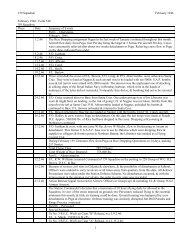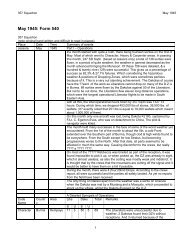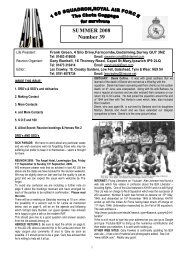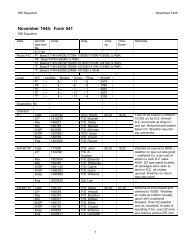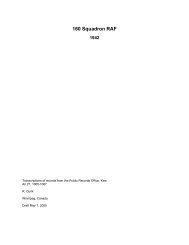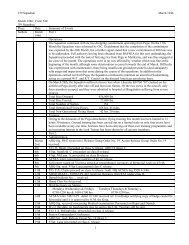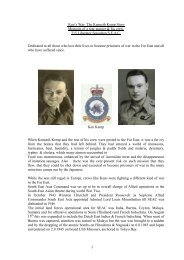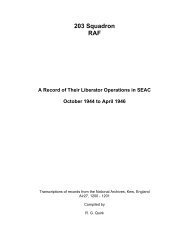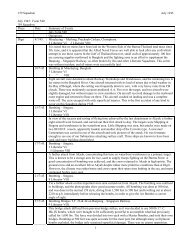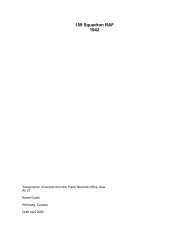RCAF Radar Personnel in WWII -North Atlantic Region-
RCAF Radar Personnel in WWII -North Atlantic Region-
RCAF Radar Personnel in WWII -North Atlantic Region-
Create successful ePaper yourself
Turn your PDF publications into a flip-book with our unique Google optimized e-Paper software.
1RUWK $WODQWL 5HJLRQ<br />
,9<br />
Fred Grahame, of Dundas,Ont., was<br />
attached to the Navy for duty at their CHL<br />
radar unit at Sumburgh Head on the<br />
extreme southern tip of the Shetlands.<br />
Here, as <strong>in</strong> the Orkneys, high w<strong>in</strong>ds made<br />
it necessary to ‘lash’ the aerial gantry to<br />
avoid damage to turn<strong>in</strong>g gear. In Nov.<br />
1942, Grahame was sent to Navy’s most<br />
northerly CHL at Saxa Vord to assist <strong>in</strong><br />
repair<strong>in</strong>g its aerial turn<strong>in</strong>g gear (probably<br />
a w<strong>in</strong>d victim).<br />
Another <strong>RCAF</strong> radar mechanic, P.T.<br />
Valeriote of Guelph, Ont., was posted to<br />
“H” Mess, HMS Fox, which turned out to<br />
be Saxa Vord on the Island of Unst.<br />
Len MacMillan, <strong>RCAF</strong>, of Calgary, was<br />
attached to the Navy and served at the<br />
CHL radar on the Island of Clett.<br />
Murdock Smith, <strong>RCAF</strong>, also of Calgary,<br />
encountered Shetland radars when his job<br />
at 70 W<strong>in</strong>g headquarters <strong>in</strong>cluded<br />
quarterly <strong>in</strong>spections and special<br />
ma<strong>in</strong>tenance on CHL stations from<br />
Dundee north to Wick and on the Shetland<br />
Islands. While at one of the other<br />
Shetland stations “ . . .a Shetland storm<br />
stripped the antenna off the Sumburgh<br />
Head Station and deposited it somewhere<br />
<strong>in</strong> the <strong>North</strong> Sea . . .” W<strong>in</strong>g ordered<br />
Murdock to go to Sumburgh Head and<br />
repair the damage. The job, completed under very difficult circumstances, apparently improved<br />
Navy-Air Force relations <strong>in</strong> the Shetlands considerably.<br />
Murdock was then sent to Fair Isle (previously mentioned), where the Navy had two CHL’s, to<br />
<strong>in</strong>stall a new, late model receiver. The job was not made easier when the piano-sized receiver, <strong>in</strong><br />
its pack<strong>in</strong>g case, was accidentally dunked <strong>in</strong> the sea while be<strong>in</strong>g unloaded from a steamer <strong>in</strong>to a<br />
small boat. Yatesbury radar school had not gone <strong>in</strong>to what to do with mundane problems such as<br />
salt-coated term<strong>in</strong>al boards! Once aga<strong>in</strong>, Canadian resourcefulness helped to foster good Navy-Air<br />
Force relations.




